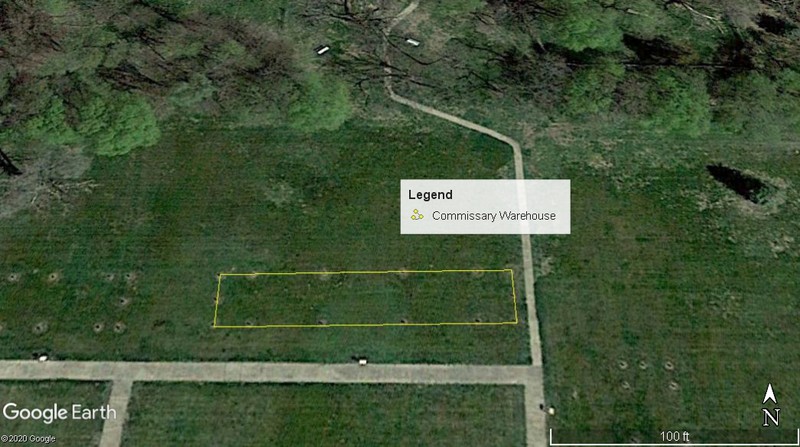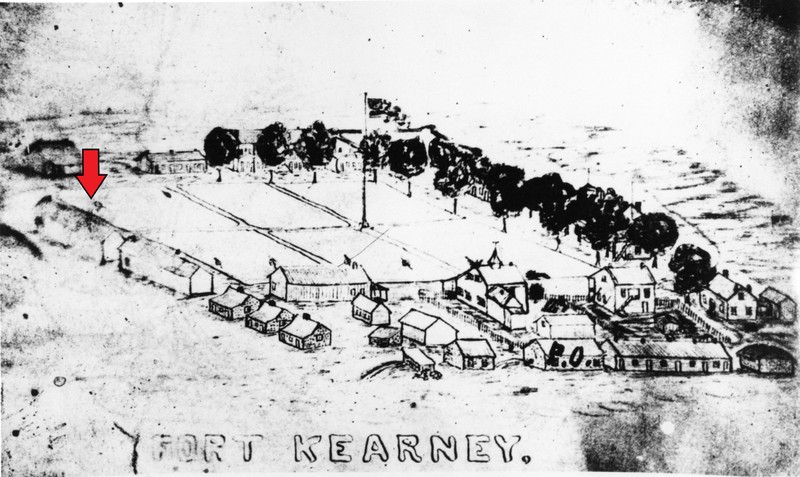Fort Kearny Commissary Warehouse
Introduction
Text-to-speech Audio
Images
Aerial map of commissary warehouse outline

Drawing of Fort Kearny showing location of commissary warehouse

Backstory and Context
Text-to-speech Audio
The new commissary warehouse erected in 1859 was placed some distance to the north of the parade ground and can be seen on several maps of Fort Kearny. Plans indicate that the building was large; 132 feet long and 24'4" wide. A depression which can still be seen today to the west of the warehouse is believed to be the site of a deep root cellar, a hypothesis consistent with the identification of the building as the commissary storehouse.
Emigrants who found their supplies inadequate could buy such commodities as grain (when available), flour, bacon, and pickled pork upon requisition from the commissary. Post gardens were inadequate to supply the vitamin-deficient diet of the garrison but buffalo meat was thought to be a source of vitamins and though professional hunters kept the garrison supplied, travelers were told to hunt their own meat.
An 1864 post-inspection stated the commissary building was in good condition, and capable of holding stores for three hundred men one year. Subsistence supplies were divided into two parts: subsistence stores, consisting of rations, such as pork, flour, coffee, candles, etc., and commissary property, which was the necessary means of issuing and preserving these stores, such as stationary, scales, measures, tools, etc.
In the early nineteenth century, the component parts of rations consisted of: three-fourths of a pound of pork, or one pound and one-fourth of fresh beef, or one pound and one-fourth of salt beef, or twelve ounces of hard bread, or one and one-fourth pounds cornmeal, and one gill of whiskey.
For every one hundred rations, the men were provided four pounds of soap, one pound and a half of candles, two quarts salt, four quarts vinegar, and twelve quarts peas or beans. The rations remained relatively unchanged until 1861, except for the addition of ten pounds of rice or hominy, ten pounds of green coffee, or, eight pounds of roasted (or roasted and ground) coffee, or, one pound and eight ounces tea, fifteen pounds of sugar, and pepper, potatoes, and molasses. Whiskey remained a part of the men's rations during most of the nineteenth century, although attempts were made to eliminate it from the diet.
Sources
Roger T Grange Jr, “Digging at Fort Kearny,” Nebraska History 44 (1963): 101-121
Mantor, Lyle E. "The History of Fort Kearny." Ph.D. diss., 1938.
Post Inspection, Fort Kearny, N.T. June 28, 1864.
Kimball, Beverly M. Fort Kearny - Guardian of the Plains. Buffalo Tales - Buffalo County Historical Society, vol. 11, no. 6. Published June 1st, 1988.
Ketchum, Sally J. Historic Furnishings Report for the Quartermaster Storehouse, Quartermaster-Commissary Department. July 29th, 2016. Accessed December 11th, 2020. https://www.nps.gov/fosc/learn/education/qmdcommissary.htm.
